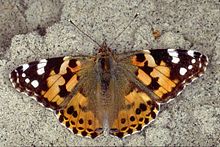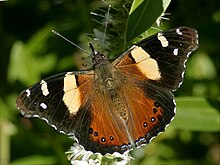Vanessa (genus)
| Vanessa | ||||||||
|---|---|---|---|---|---|---|---|---|

Admiral ( Vanessa atalanta ) |
||||||||
| Systematics | ||||||||
|
||||||||
| Scientific name | ||||||||
| Vanessa | ||||||||
| Fabricius , 1807 |


Vanessa is a genus of noble butterflies (Nymphalidae) with around 20 species. In Central Europe the admiral ( Vanessa atalanta ) and the painted lady ( Vanessa cardui ) occur.
features
The moths of the genus Vanessa have a row of isolated white spots on the upper side on a dark brown to black background on the wing tip. On the underside of the hind wings, a row of eye-spots runs along the outer edge. In the two species Vanessa hippomene and Vanessa dimorphica from southern Africa the white spots are greatly reduced.
Aberration elymi
A rare aberration elymi is known from the species Vanessa braziliensis , Painted Lady ( Vanessa cardui ), Vanessa myrinna , American Painted Lady ( Vanessa virginiensis ), Vanessa annabella and Vanessa carye . This lacks the discal wing drawing, the subapical dark elements merge and it shows a row with white, submarginal spots. This aberration is likely caused by the cold during the pupal phase.
Systematics
Assignment of species
Originally the genus, which was called "Eckflügler" in German, was formed by the peacock butterfly ( Inachis io ), the small fox ( Aglais urticae ) and species such as the mourning cloak ( Nymphalis antiopa ) and the large fox ( Nymphalis polychloros ). The painted lady and admiral species that characterize the genus today were assigned to the genus Pyrameis Hübner 1819 at the beginning of the 20th century . This name is now considered a subordinate synonym. Other obsolete synonyms of this genre are Cynthia Fabricius 1807, Bassaris Hübner 1821, Pyrameides Hübner 1826, Ammiralis Rennie 1832 and Neopyrameis Scudder 1889.
In the literature, the painted lady is often referred to as Cynthia cardui , since this and closely related species were assigned to the genus Cynthia Fabricius 1807 from the 1970s . Its caterpillar has a very different spectrum of food plants compared to the other Vanessen, the butterfly comes from a different fauna and does not use windfalls . In Karsholt & Razowski (1996) the butterfly is assigned to Vanessa again and today Cynthia is considered a subgenus within the genus Vanessa . In experiments with several species of the genus for the color pattern formation of the black spots on the wings, differences between Vanessa atalanta , Vanessa indica ( Indian admiral ) on the one hand and Vanessa cardui on the other hand were also found, which indicate a stronger genetic difference. This was later confirmed by genetic studies.
Vanessa dimorphica and Vanessa hippomene have a less typical appearance, as the white spots on the upper forewing are greatly reduced and, with their short tails on the hind wings, they more closelyresemblethe species of the genus Antanartia found in Africa. Only in 2011 was the closer relationship to the genus Vanessa recognizedby genetic examinationsand it was therefore removed from the genus Antanartia .
Vanessa carye was divided into the now recognized species Vanessa annabella and Vanessa carye by William Dewitt Field in 1971 due to differences in the female and male genitals . Previously, annabella was considered a subspecies of Vanessa carye . With Scott 1986 the split is still doubted due to the small external differences. Vanessa buana and Vanessa dilecta are genetically and in the male genitalia very similar, which is why the species status is not certain. It could also be an allopatric distribution of a species in Sulawesi and West Timor .
Classification of some species at the beginning of the 20th century according to Adalbert Seitz and Arnold Spuler :
-
Vanessa
- Vanessa antiopa , mourning gown (Seitz) (Spuler)
- Vanessa io , peacock butterfly (Seitz) (Spuler)
- Vanessa urticae , Little Fox (Spuler)
- Vanessa polychloros , Big Fox (Spuler)
- Vanessa xanthomelas , Eastern Great Fox (Spuler)
- Vanessa Milberti (Seitz)
- Vanessa cyonomelas (Seitz)
-
Pyrameis
- Pyrameis atalanta , Admiral (Seitz) (Spuler)
- Pyrameis cardui , with the From kershawi Painted Lady (Seitz) (Spuler)
- Pyrameis huntera , with the forms virginiensis , braziliensis and altissima (Seitz)
- Pyrameis carye (Seitz)
- Pyrameis indica with the shape vulcania (Seitz)
- Pyrameis terpsichore (Seitz)
- Pyrameis myrinna (Seitz)
Some species of the genus Cynthia in the late 20th century:
- Cynthia annabella
- Cynthia carye
- Cynthia cardui , painted lady
- Cynthia kershawi
- Cynthia virginiensis , American painted lady
Internal system
Due to the genetic distance of the species, five groups can be formed with closely related species:
- Basal Vanessa carye group
- Vanessa Annabella ( Field , 1971)
- Vanessa carye ( Huebner , [1812])
-
Vanessa itea group (Australian species)
- Vanessa gonerilla ( Fabricius , 1775)
- Vanessa itea , ( Fabricius , 1775)
-
Vanessa hippomene group
- Vanessa dimorphica ( Howarth , 1966)
- Vanessa hippomene ( Huebner , 1823)
- Vanessa abyssinica ( Felder & Felder , 1867)
-
Vanessa atalanta group (admirals)
- Vanessa atalanta , admiral , ( Linné , 1758)
- Vanessa buana ( Fruhstorfer , 1898)
- Vanessa dejeanii ( Godart , [1824])
- Vanessa dilecta Hanafusa , 1992
- Vanessa indica , Indian admiral , ( autumn , 1794)
- Vanessa samani ( Hagen , 1895)
- Vanessa tameamea ( Eschscholtz , 1821)
- Vanessa vulcania , Canarian Admiral , ( Godart , 1819)
-
Vanessa cardui group (Painted Lady)
- Vanessa braziliensis ( Moore , 1883)
- Vanessa cardui , Painted Lady , ( Linné , 1758)
- Vanessa kershawi ( McCoy , 1868)
- Vanessa myrinna ( Doubleday , 1849)
- Vanessa altissima ( Rosenberg et Talbot , 1914)
- Vanessa terpsichore ( Philipi , 1859)
- Vanessa virginiensis , American painted lady , ( Drury , [1773])
| Genus Vanessa | ||||||||||||||||||||||||||||||||||||||||||||||||||||||||||||||||||||||||||||||||||||||||||||||||||||||||||||||||||||||||||||||||||||
|---|---|---|---|---|---|---|---|---|---|---|---|---|---|---|---|---|---|---|---|---|---|---|---|---|---|---|---|---|---|---|---|---|---|---|---|---|---|---|---|---|---|---|---|---|---|---|---|---|---|---|---|---|---|---|---|---|---|---|---|---|---|---|---|---|---|---|---|---|---|---|---|---|---|---|---|---|---|---|---|---|---|---|---|---|---|---|---|---|---|---|---|---|---|---|---|---|---|---|---|---|---|---|---|---|---|---|---|---|---|---|---|---|---|---|---|---|---|---|---|---|---|---|---|---|---|---|---|---|---|---|---|---|
|
||||||||||||||||||||||||||||||||||||||||||||||||||||||||||||||||||||||||||||||||||||||||||||||||||||||||||||||||||||||||||||||||||||
Fossil and unidentified species

The fossil Vanessa amerindica Miller & Brown , 1989, which is around 35 million years old and which is very similar to Vanessa indica, is known from the Oligocene . It was found in the Florissant Formation in Colorado . A picture by the British painters Henry Seymer (1714–1785) and Henry Seymer jun. (1745-1800). The picture shows a butterfly from her collection from Newfoundland , which does not resemble any current North American species, but rather reminds of Vanessa indica . The Seymers are known for their detailed illustrations, so it is not clear whether a representative of the Vanessa indica complex lived in North America until a few centuries ago. The butterfly has not survived, as the complete collection after the death of Henry Seymer sen. was destroyed.
External system
Vanessa is the sister group of Hypanartia Hübner, 1821, which is restricted to tropical America .
Features and way of life
Some species are migratory butterflies and have large distribution areas, while others show no migratory behavior and have rather small distribution areas. The caterpillars often feed on nettles (Urticaceae) and spin conspicuous leaf bags from leaves, whereby the petiole of this leaf is usually gnawed in part and the shelter hangs down. The caterpillar only leaves the leaf bag when it has eaten it up to such an extent that it no longer offers adequate protection. The moths of many species are attracted by windfalls.
Geographical distribution
The genus is distributed worldwide and occurs on all continents except for Antarctica . The painted lady ( Vanessa cardui ) is a migratory butterfly and occurs all over Europe , North Africa , Asia , North America and Australia up to an altitude of about 3,000 meters. The admiral ( Vanessa atalanta ) is also a migrant butterfly and is distributed from North America to Guatemala , Haiti , New Zealand and in North Africa and Europe to western Asia. The Canarian Painted Lady ( Vanessa vulcania ) is endemic to the Canary Islands and Madeira . In Africa come Vanessa abyssinica and Vanessa dimorphica and South Africa and Madagascar comes Vanessa hippomenes ago. Vanessa annabella , Vanessa virginiensis live in North America, Vanessa braziliensis , Vanessa carye , Vanessa altissima and Vanessa terpsichore live in South America . The Indian admiral Vanessa indica is widespread in Southeast Asia from India to China and Japan , in the south to Thailand . In summer the moths migrate, for example. Partly far north to southern Siberia . On the Russian Pacific coast, butterflies have been found as far as the Kamchatka peninsula . Vanessa buana (south of Sulawesi, Indonesia), Vanessa dilecta (Timor) and Vanessa dejeanii (Java to Sumatra and Mindanao) occur in Southeast Asia . Vanessa itea and Vanessa kershawi live in Australia and New Zealand, Vanessa gonerilla are endemic to New Zealand and Vanessa tameamea to Hawaii .
Origin of name
The name of the genus probably comes from the female given name Vanessa . There is also suspicion that it is a variant of Phanessa , a Greek deity. However, this is unlikely, since Johann Christian Fabricius , who named this genus, usually used the original form of mythological names, which in this case would be Phanes . Spuler suspects that it is derived from the Greek Ψανή (gloss) because of the beautiful coloring of the species.
Kynthia is an epithet of the Greek goddess Artemis (Roman Diana), Greek "(the) coming from Mount Kynthos", whereby the Latin spelling is Cynthia.
Pyrameis is derived from the Greek proper name Pyramos.
supporting documents
literature
- Richard I. Vane-Wright, Harold WD Hughes: Did A Member Of The Vanessa Indica Complex (Nymphalidae) Formerly Occur In North America? In: Lepidopterists 'Society (Ed.): Journal of the Lepidopterists' Society . tape 61 , no. 4 , December 14, 2007, ISSN 0024-0966 , p. 199-212 ( online ).
- Niklas Wahlberg, Daniel Rubinoff: Vagility across Vanessa (Lepidoptera: Nymphalidae): mobility in butterfly species does not inhibit the formation and persistence of isolated sister taxa . In: Systematic Entomology . tape 36 , no. 2 . Wiley, April 2011, p. 362-370 , doi : 10.1111 / j.1365-3113.2010.00566.x ( online [accessed January 13, 2013]).
- Scott, James A .: The butterflies of North America . Stanford University Press, Stanford, California 1986, ISBN 0-8047-2013-4 , pp. 280-284 .
Individual evidence
- ^ Arnold Spuler: The butterflies of Europe . tape 1 . E. Schweitzerbartsche Verlagbuchhandlung, Stuttgart 1908, p. 19 .
- ↑ Gerardo Lamas: Ocoourence of the Elymi Aberrant Phenotype in Vanessa carye (Huebner) (Nymphalidae). In: The Journal of Research on the Lepidoptera. 22 (2): pp. 115-117, 1983 PDF
- ↑ a b Arnold Spuler: The butterflies of Europe . tape 1 . E. Schweitzerbartsche Verlagbuchhandlung, Stuttgart 1908, p. 16 f .
- ^ Niklas Wahlberg: Nymphalini. In: www.nymphalidae.net. Archived from the original on June 25, 2012 ; Retrieved January 6, 2008 .
- ^ The University of Arizona College of Agriculture and Life Sciences and The University of Arizona Library: Vanessa. In: Tree of Life Web Project. Retrieved January 8, 2008 .
- ^ Otaki Joji M., Yamamoto Haruhiko: Color-pattern Modifications and Speciation in Butterflies of the Genus Vanessa and its Related Genera Cynthia and Bassaris . In: The Zoological Society of Japan (Ed.): Zoological science . tape 21 , no. 9 , September 2004, ISSN 0289-0003 , p. 967-976 ( online [accessed January 6, 2008]).
- ↑ a b Wahlberg, Rubinoff, p. 362.
- ^ Wahlberg, Rubinoff, p. 367.
- ↑ The Palaearctic Butterflies . In: Adalbert Seitz (ed.): The large butterflies of the earth . tape 1 . Alfred Kernen, Stuttgart 1909, p. 198 ff .
- ↑ The large butterflies of the American fauna area . In: Adalbert Seitz (ed.): The large butterflies of the earth . tape 5 . Alfred Kernen, Stuttgart 1907, p. 457 ff. (English edition) .
- ↑ Wahlberg, Rubinoff, p. 365.
- ↑ a b Vane-Wright, Hughes 2007, p. 205.
Web links
- Photos of some Vanessa species
- Photos and links to the genus Vanessa
- Vanessa at Fauna Europaea




